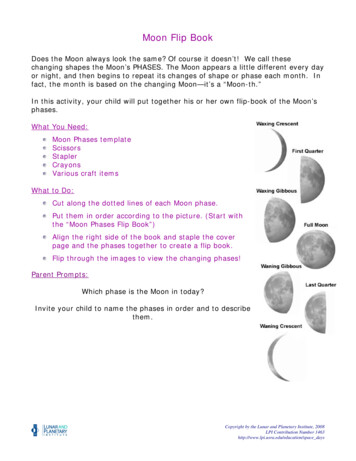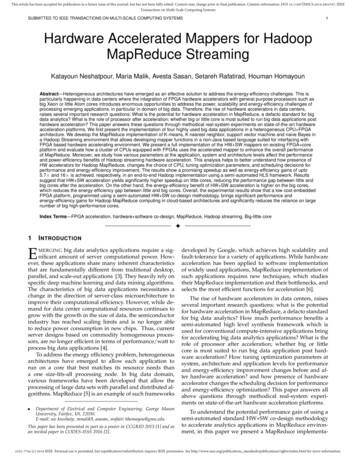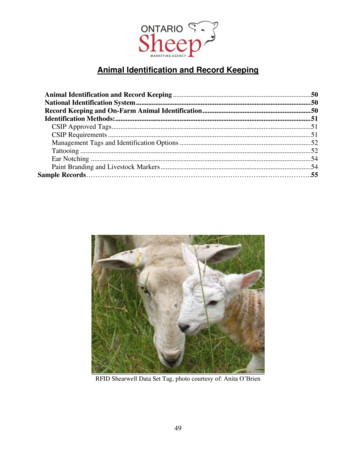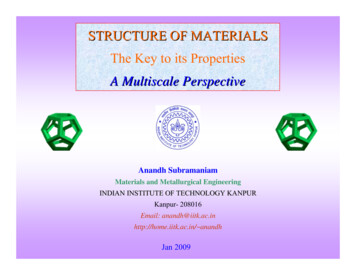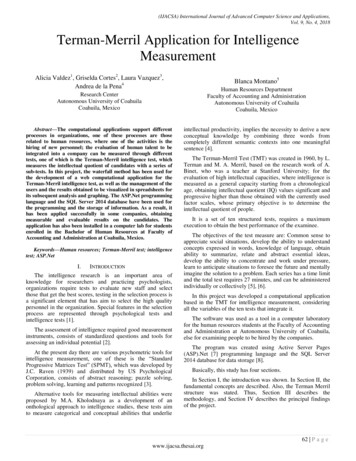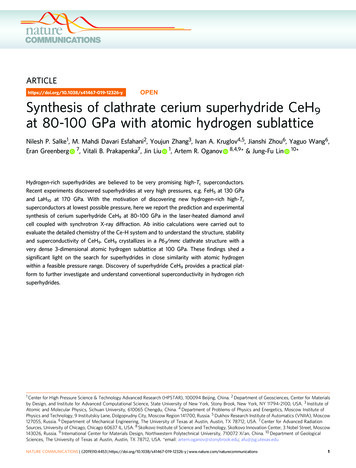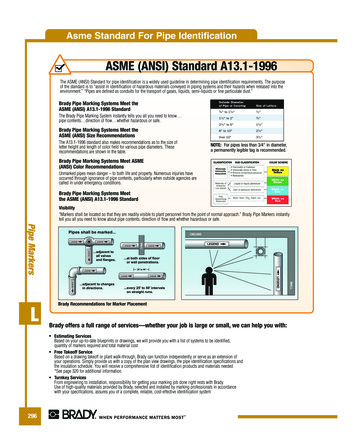
Transcription
Acta Poloniae Pharmaceutica ñ Drug Research, Vol. 71 No. 2 pp. 301ñ309, 2014ISSN 0001-6837Polish Pharmaceutical SocietyIDENTIFICATION OF PHASES OF VARIOUS OIL, SURFACTANT/CO-SURFACTANTS AND WATER SYSTEM BY TERNARY PHASE DIAGRAMHAROON K. SYED and KOK K. PEH*School of Pharmaceutical Sciences, Universiti Sains Malaysia, 11800 Minden, Penang, MalaysiaAbstract: The objective of this study was to select appropriate surfactants or blends of surfactants and oil tostudy the ternary phase diagram behavior and identify various phases obtained from the oil and surfactant/surfactant mixture combinations of different HLB. The phases include conventional emulsion, gel/ viscous andtransparent/translucent microemulsion. Pseudoternary phase diagrams of water, oil and S/Smix of various HLBvalues range of 9.65ñ15 were constructed by using water titration method at room temperature. Visual analysis, conductivity and dye dilution test (methylene blue) were performed after each addition and mixing of water,to identify phases as microemulsion, o/w or w/o emulsion (turbid/milky) and transparent gel/ turbid viscous.High gel or viscous area was obtained with Tween 80 and surfactant mixture of Tween 80 and Span 80 with alloils. The results indicated that non-ionic surfactants and PG of different HLB values exhibited differentpseudoternary phase diagram characteristics but no microemulsions originated from mineral and olive oils. Thew/o emulsion occupied a large area in the ternary phase triangle when HLB value of the surfactant/Smixdecreased. The o/w emulsion area was large with increasing HLB value of surfactant/Smix.Key words: Pseudoternary phase diagram, nonionic surfactants, emulsiondrug delivery systems, their identification and characterization (2ñ9).For making a productive formulation, study ofphases obtained from several combinations of oil,surfactant/surfactant and co-surfactant mixture,water and their behavior is required. Numerous oilsand surfactants are considered as satisfactory foodgrade materials or also being used in the pharmaceutical industry (10). The selection and choice ofsurfactant and co-surfactant is of great importance.Generally non-ionic surfactants are chosen becauseof their good cutaneous tolerance, lower irritationpotential and toxicity (11). Ionic surfactants are usedrarely in special cases (12). Non-ionic surfactants(13, 14), short and medium chain alcohols (15, 16),alkanoic acids, alkanediols and alkyl amines (17)can function as co-surfactants that can reduce surface tension and increase the flexibility of the interfacial film.The aim of this study was to identify andselect the surfactant or optimal blends of surfactantsand oil using HLB values, and then, investigate thepseudoternary phase diagram behavior of mixturesof these surfactants with different oil and water.The pseudoternary phase diagrams were construct-Generally, emulsions, micro or nanoemulsions,are dispersed systems of different ratios of oil, surfactant(s) and aqueous phase. The different phases,their behavior and changes in volume fraction of different phases of the system can be checked by usingpseudoternary phase diagram. A system consistingof water, oil, surfactant (or surfactants mixture) withvarious phases may be depicted on a phase tetrahedron whose apexes, respectively, present the purecomponents. The phase behavior can easily reporton pseudoternary triangles. Apparently, a fixed(weight or volume) ratio must be selected for anytwo of the components and one of the triangle vertices presents 100% of the binary mixture.Multicomponent phase diagrams are generallybased on constant ratios of surfactant to water or cosurfactant-to-surfactant (1).Oil/lipid based formulations have been developed in the past by using phase diagrams. To identify regions like o/w microemulsion or nanoemulsion,coarse emulsions and gel/viscous by dissolving specific oil/surfactant/surfactant mixture ratio upondilution of water can be obtained by using phase diagram. The past research studies showed the importance of phase diagram for developing oil based* Corresponding author: e-mail: kkpeh@usm.my; kkpehken@gmail.com; mobile: 006-0124623399301
302HAROON K. SYED and KOK K. PEHed in order to identify the types of dispersion systems formed by the mixtures at different concentrations of their components. Our interest at this timeis in viscous or gel phase. The systems composed ofTween 80, water, four oils such as isopropyl myristate (IPM), eucalyptus oil (EO), olive oil (OO) andmineral oil (MO) and co-surfactants i.e., propyleneglycol (PG), Span 80, Span 20 were selected forscreening. Molecular structure and HLB value ofthe surfactants are presented in Table 1. All thesesurfactants, co-surfactant and oils are generallyaccepted as safe, nonirritant and nontoxic for use ina number of pharmaceutical, cosmetic, and foodproducts (18).EXPERIMENTALMaterialsEucalyptus oil and olive oil were purchasedfrom Jiaxing, Sunlong Industrial and Trading Co.Ltd., China. Mineral oil was purchased fromMoksha Life Style Products, New Delhi, India.Isopropyl myristate was purchased from DerifatsChemicals Sdn. Bhd., Malaysia. Propylene glycol,Tween 80, Span 20 and Span 80 were purchasedfrom Sigma-Aldrich, USA. Other reagents or chemicals used were of analytical grade. The materialswere used as received.METHODSConstruction of ternary phase diagramThe oils employed were olive oil (OO), mineral oil (MO), isopropyl myristate (IPM) and eucalyptus oil (EO). The physico-chemical properties of theoils are presented in Table 2. The molecular volumes (v) of the oils were calculated as:v 1.66 (Mr/d)(19)where Mr represents the relative molecular mass (ing/mol) of the oil and d is the density (in g/cm3). Thevalues of Mr and d were taken from the manufacturerís specifications.The pseudoternary phase diagrams consistingof oil, water and surfactant/surfactant and co-surfactant mixture of different HLB values were constructed using water titration method. The ratio ofsurfactant to co-surfactant was fixed at 1 : 1 on theweight basis. Each oil was mixed with surfactant orsurfactant and co-surfactant mixture at ratios of 0.5: 9.5, 1.0 : 9.0, 1.5 : 8.5, 2.0 : 8.0, 2.5 : 8.5, 3.0 : 7.0,3.5 : 6.5, 4.0 : 6.0, 4.5 : 5.5, 5.0 : 5.0, 6.0 : 4.0, 7.0: 3.0, 8.0 : 2.0 and 9.0 : 1.0 (w/w). Four types of surfactant (Tween 80, Tween 80 and Span 20, Tween80 and Span 80, Tween 80 and propylene glycol)were used. Distilled water was added in incrementsof 100 µL by micropipette at room temperature (26 2OC) to the oil and surfactant or surfactant and co-Table 1. Selected surfactants for screening.NameTween 80(polyoxyethylenesorbitan monooleate)HLBMolecular structure15Polysorbate 80Span 20sorbitan laurate(sorbitan monododecanoate)8.6Sorbitan monolaureateSpan 80sorbitan monooleate(sorbitan (Z)-mono-9octadecenoatePropylene glycol4.3Sorbitan monooleate4.45OH OH-CH2-CH-CH3-OH
303Identification of phases of various oil, surfactant/cosurfactants and.Table 2. Chemical structures, relative molecular masses (Mr), density (d) (at 20 C) and calculated molecular volumes (v) of oils investigated.Mr (g/mol)d (g/cm3)v (cm3/mol)Isopropyl myristate270.450.854525.7Eucalyptus oil154.250.913280.45As specified in USPñ0.875ñAs specified by manufacturerñ0.909ñOilChemical structureMineral oilOlive oilTable 3. Percentage of IPM, Tween 80 and PG or water using 1.0 : 9.0 oil and surfactant or surfactant and co-surfactant ratio.IPM(µL)Tween 80 & PG(µL)Water*(µL)Total volume(µL)IPM(%)Tween .90*The amount of water is varied to provide a water concentration in the range of 9% to 90% of total volume.surfactant mixture until 90.90% w/w. The sampleswere vigorously mixed with a vortex mixer for 2min and kept at room temperature (26 2OC) for 24h to reach equilibrium before the next addition ofwater. The percentages of IPM, Tween 80 and PGand water for oil and surfactant or surfactant andco-surfactant at ratio of 1.0 : 9.0 are presented inTable 3.Visual inspectionVisual inspection was made after each additionof water to the oil and surfactant or surfactant andco-surfactant mixture. The samples were identifiedas microemulsions when they appear as transparent/translucent and easily flowable liquid. Noattempt was made to distinguish between oil-inwater, water-in-oil or bicontinuous type microemul-
304HAROON K. SYED and KOK K. PEHsions. The samples were identified as emulsionswhen they appeared as milky or turbid liquids. Thesamples were identified as gel when they did notshow a change in the meniscus after tilting to anangle of 90O. All these categories were plotted on atriangular graph as ternary or pseudoternary phasediagram using Chemix School 3.51 software, ArneStandnes USA.Physical appearance of emulsionsThe visual qualities of the emulsion mixtureswere noted as turbid or milky liquids.Electrical conductivity testA pair of electrodes (Sanwa YX-360TRDMultitester, Japan) connected to an electric bulb wasdipped into an emulsion. If the emulsion is o/w type,the electric bulb glows.Staining test/dye-solubility testWater soluble dye, methylene blue solution of10 µL was added to the emulsion. If the continuousphase is water (o/w emulsion), the dye will dissolveuniformly throughout the system. If the continuousphase is oil (w/o emulsion), the dye will remain ascluster on the surface of the system (20).RESULTS AND DISCUSSIONA wide variety of structures and phases can beformed by mixing oil, water and surfactants in different ratios. Molecular and structural examinations,concentration of surfactants and other ingredientscan expose the existence of microemulsions, typicalemulsions, crystalline and lamellar structuresdepending on the ratio of the components.Recognition of different phases and structures canbe achieved by simple visual inspection of theirphysical appearance (e.g., microemulsions (ME) aretransparent/translucent, emulsions are nontransparent and phases separate after a while; and gels (21,22). The appearance of ME, emulsion and gel is presented in Figure 1.It is important to find the chemical type of surfactant which best matches that of the oil, becausethe chain length compatibility of a surfactant and oilis critical for the formation of emulsion systems.Surfactant type plays a major role in determining therheological properties and droplets size of the systems (9). Choice of surfactant is crucial to obtain thedesired formulation. Each oil and surfactant has aspecific HLB value. The HLB of the selected surfactant or surfactant and co-surfactant that matchesthe HLB of the selected oil provides the lowestinterface tension between the oil and water phases.The HLB of the selected surfactant(s) reflects thestability of the system and can be obtained when theHLBs of the surfactant and oil are similar (8). Thestability of emulsions is improved if a combinationof surfactants is used because solubilization reachesthe maximum and the smallest particles are formedwhen the hydrophilic-lipophilic balance of a surfactant is optimal in a given oil-water system.Likewise, a type of oil, whether it is triglycerideform or long chain hydrocarbon, can change thephysical properties of the systems.Figure 1. a ñ Transparent ME, b ñ turbid emulsion, c ñ gel (left to right)
Identification of phases of various oil, surfactant/cosurfactants and.305TurbidTurbidFigure 2. Ternary phase diagrams of isopropyl myristate (IPM), eucalyptus oil (EO), mineral oil (MO) and olive oil (OO) with Tween 80and waterTurbidTurbidFigure 3. Ternary phase diagrams of isopropyl myristate (IPM), eucalyptus oil (EO) and olive oil (OO) with Tween 80 : Propylene glycol(PG) (Smix 1 : 1), and water
306HAROON K. SYED and KOK K. PEHTurbidTurbidFigure 4. Ternary phase diagrams of Isopropyl myristate (IPM), Eucalyptus oil (EO), Mineral oil (MO) and Olive oil (OO) with Tween80: Span 20 (Smix 1:1) and waterNon-ionic surfactants in general, Tween andSpan in particular are safe agents for all biologicaltissues in general and for skin specifically (23,24). These non-ionic emulsifiers are compatiblewith various ingredients used in the preparation ofemulsions and are not affected by pH. A combination of lipophilic and hydrophilic non-ionic surfactants is able to build highly structured emulsions.Tween 80 is a derivative of Span 80, but ishydrophilic in nature because the hydroxyl groupson the sorbitan ring are replaced and substitutedwith bulky polyoxyethylene groups. This substitution makes Tween 80 more soluble in water, so ittends to form oil-in-water emulsions. Span 80 is aviscous, lipophilic, emulsifying liquid agent, whichtends to form water-in-oil emulsions.Polyols such as propylene glycol (PG) andshort-chain alcohols are known to act as co-surfactants. Hence, it is presumed that a considerable partof PG is incorporated into the surfactant layer andwill increase the interfacial fluidity, and the otherpart of PG will decrease the polarity of the waterbecause PG is mainly soluble in water. PG is one ofthe least hydrophilic simple polyols, that is solublein water but practically non-soluble in the oil phase(25). In comparison with other alcohols, PG is relatively tolerable by the skin.Different combinations of oil, surfactants andwater when mixed together produce either typicalemulsion or microemulsion in the form of o/w orw/o. Bicontinuous system can also be formed incase of microemulsion system where each phase ofwater and oil is found as a continuous phase.Pseudoternary phase diagram construction is thebest way to study all types of formulations that canoriginate from mixing of surfactants, water and oil.This study is performed to predict the optimizedcompositions of surfactants, oil and water in thedevelopment of ME, emulsion or gel.
Identification of phases of various oil, surfactant/cosurfactants and.307TurbidTurbidFigure 5. Ternary phase diagrams of isopropyl myristate (IPM), eucalyptus oil (EO), mineral oil (MO) and olive oil (OO) with Tween 80: Span 80 (Smix 1 : 1) and waterFigures 2 to 5 are the phase diagrams of mixtureof IPM, eucalyptus oil, mineral oil, olive oil, waterand surfactant or their mixtures with HLB values of15.00, 9.72, 11.80 and 9.65, respectively. A large areaof transparent/clear solution was formed in the oilrich regions. The ME areas were found to be attachedto the borders of the diagrams where water and oilratio was low and the surfactant ratio was high. Allfigures showed the presence of transparent ME areaexcept Figures 3c and 3d, representing the diagramsof mineral oil and olive oil with surfactant mixtures ofTween 80 : PG and water with HLB value of 178,7589.72. Attempts to obtain microemulsions using mineral oil and olive oil were not successful. Mineral oilis a mixture of high molecular weight hydrocarbons.Olive oil contains predominantly long-chain triglycerides of oleic acid. Thus, the molecular weight ofmineral oil and olive oil is most probably too high toassist in the formation of microemulsion (26). No liquid crystalline structure was observed.Incorporation of co-surfactant like PGincreased the maximum amount of incorporatedwater in the oil-surfactant system with themicroemulsion zone being increased compared tothe surfactant system (Fig. 3b). The presence of PGabolished the region of the gel from the phase diagrams (Fig. 3) compared to the surfactant system(Fig. 2). Breaking of the gel was reported after introduction of short chain alcohol with up to 4 carbonatoms (21).W/O emulsion occupied the lower right regionof the triangle phase diagram (oil rich region). Onthe other hand, o/w emulsion occupied the middleand left regions (water rich regions) of the trianglephase diagram. The formation of w/o emulsion oro/w emulsion depends on the composition of theemulsifier and its solubility in the oil and water (27).The phase diagrams obtained also showed that areasof w/o dispersions decreased as the HLB value ofthe surfactant system increased. This is in accor-
308HAROON K. SYED and KOK K. PEHdance with the theory of HLB of surfactant, whichstated that the types of surfactant used has more tendencies to produce the emulsion type in which it ismore soluble in the external phase (9). Tween 80 :Span 80 at an HLB of 9.65 had the tendency to forma large area of w/o emulsion as shown in Figure 4.Similarly, a larger o/w area was formed by the mixture of Tween 80 : Span 20 at a higher HLB value of11.8 (Fig. 4). Tween 80 formed large oil-in-wateremulsion areas compared with water-in-oil emulsion on the oil-water axis (Fig. 1) due to higher HLBvalue of 15 of Tween 80, which promoted the formation of o/w emulsion (28). O/W and w/o emulsions have been used for a long time in the pharmaceutical industry and cosmetic industry (29, 30).It can be observed in Figures 2, 4 and 5 that thegel/viscous area was formed when the water contentin the system was in the range of 25 to 60%. It wasfound that water content below 25% was insufficientto hydrate the polyoxyethylene groups, which arecritical for the swelling of surfactant chains todemonstrate the gel structure. When the water contentwas above 60%, the distance between the polyoxyethylene groups increased and destabilized the gelstructure resulting in breaking of the swelled gel (31).Phase diagrams containing Tween 80 (Fig. 2)and those containing surfactant and co-surfactant ofTween 80 (HLB 15) and Span 80 (HLB 4.3) (Fig. 5)exhibited higher gel area compared to Tween 80 andSpan 20 (HLB 8.6) (Fig. 4). The results showed thatwater and surfactant and co-surfactant mixture ofTween 80 and Span 80 having HLB of 9.65 formedlarger gel area than that of mixture of Tween 80 andSpan 20 having HLB value of 11.8. The results indicated that a mixture of two non-ionic surfactants withbig difference in HLB values between them might beable to produce stable preparations. This may be dueto the fact that surfactants with very low HLB valuedissolved in oil phase and the surfactant with highHLB value dissolved in the water that enable them tofunction together well enough to exert stronger effectthan surfactant and co-surfactant mixture havingcloser HLB values (8). The results indicated thatTween 80 alone and surfactant mixture of Tween 80and Span 80 would be better than surfactant mixtureof Tween 80 and Span 20 for forming emulsions withgel properties. Since the Tween 80 and Span 20showed small viscous area, this surfactant combination was excluded from further study.CONCLUSIONThis phase diagram study provides valuableinformation on the role that structure of the surfac-tant, co-surfactant, and oil plays in determining theproperties of the system at any composition. It wasobserved that a proper mixture of surfactants isachieved when surfactants at lower and higher HLBare blended. When the difference between thehydrophilic and lipophilic surfactants will begreater, the better would be the coverage by mixtures at the interface. Tween 80 alone and surfactantmixture of Tween 80 and Span 80 produced highviscous or gel area. The interesting results obtainedwith surfactant mixture of Tween 80 and PG, thatsupported the formation of ME and turbid emulsionphases but no gel phase was appeared with this combination in all oils. Except Tween 80 and PG combination, the phase diagrams containing other nonionic surfactant mixture and Tween 80 alone,showed the appearance of different phases with oils.This study will be very useful in formulating a delivery system in pharmaceutical industry as well as incosmetics and personal care products.AcknowledgmentsThe authors thank Universiti Sains Malaysiafor the graduate assistant scheme and RU grant(1001/PFARMASI/815071) and PRGS grant(1001/PFARMASI/844074) support.REFERENCES1. Fanun M.: in Colloid and surface researchtrends, 1st edn., pp. 107ñ146, P.K. Fong, NewYork 2007.2. Nazzal S., Smalyukh I.I., Lavrentovich O.D.,Khan M.A.: Int. J. Pharm. 235, 247 (2002).3. Rao S.V.R., Shao J.: Int. J. Pharm. 362, 2(2008).4. Zhang P., Liu Y., Feng N., Xu J.: Int. J. Pharm.355, 269 (2008).5. Elnaggar Y.S.R., El-Massik M.A., AbdallahO.Y.: Int. J. Pharm. 380, 133 (2009).6. Shafiq S., Shakeel F., Talegaonkar S., AhmadF.J., Khar R.K., Ali M.: Eur. J. Pharm.Biopharm. 66, 227 (2007).7. Kang B.K., Lee J.S., Chon S.K., Jeong S., YukS.H., Khang G., Lee H.B., Cho S.H.: Int. J.Pharm. 274, 65 (2004).8. Elrashid S.M., Mohamed H.F.S., MuthannaF.A., Ghassan Z.A., Munavvar A.S., AzminM.N.: Drug Des. Devel. Ther. 5, 311 (2011).9. Muthanna F.A., Ghassan Z.A., MohamedH.F.S., Mallikarjun C., Mun F.Y., ElrashidS.M., Ibrahim M.S et al.: Int. J. Drug. Dev. 3, 95(2011).
Identification of phases of various oil, surfactant/cosurfactants and.10. Duro R., Souto C., Gomez-Amoza J.L.,Martinez-Pacheco R., Concheiro A.: Drug.Devel. Ind. Pharm. 25, 817 (1999).11. Nirmala G., Padmini R., Rashmi M.: Ind. J.Pharm. Edu. Res. 45, 100 (2011).12. Jiao J., Burgess D.: AAPS. J. 5, 62 (2003).13. Sagitani S.H., Friberg.: J. Disper. Sci. Technol.1, 151 (1980).14. Osborne D.W., Middleton C.A., Rogers R.L.: J.Disper. Sci. Technol. 9, 415 (1988).15. Attwood D., Mallon C., Taylor C.J.: Int. J.Pharm. 84, 5 (1992).16. Aboofazeli R., Patel N., Thomas M., LawrenceM.J.: Int. J. Pharm. 125, 107 (1995).17. Aboofazeli R., Lawrence C.B., Wicks S.R.,Lawrence M.J.: Int. J. Pharm. 111, 63 (1994).18. Viyoch J., Klinthong N., Siripaisal W.:Naresuan Univ. J. 11, 29 (2003).19. Richardson, C.J., Mbanefo, A., Aboofazeli, R.,Lawrence, M.J., Barlow, D.J.: J. Colloid Interf.Sci. 187, 296 (1997).20. Aulton M.E.: in Pharmaceutics The Science ofDosage Form Design, 2nd edn., pp. 282ñ299,Churchill Livingstone Press, Spain 2002.21. Alany R.G., Tucker I.G., Davies N.M., RadesT.: Drug Devel. Ind. Pharm. 27, 31 (2001).30922. Mads K.: Adv. Drug Deliv. Rev. 54, 77 (2002).23. Nattiya S., Sarunyoo S., Prapaporn B.: 35thCongress on Science and Technology, pp. 1ñ6,The Science Society of Thailand with BBU(2007).24. Baroli B., LÛpez-Quintela M.A., DelgadoCharro M.B., Fadda A.M., Blanco-MÈndez J.: J.Control. Release 69, 209 (2000).25. Whitehead K., Karr N., Mitragotri S.:Inflammopharmacology 25, 1782 (2007).26. Nissim G., Anan Y., Martin E.L., Veronique C.,Heribert J.W.: J. Agric. Food Chem. 49, 2552(2001).27. Djekic L., Primorac M.: Int. J. Pharm. 352, 231(2008).28. Golemanov K., Tcholakova S., Denkov N.,Gurkov T.: Langmuir 22, 3560 (2006).29. Yaghmur A., Campo L., Aserin A., Garti N.,Glatter O.: Phys. Chem. Chem. Phys. 6, 1524(2004).30. Marti-Mestres G., Nielloud F.: J. Dispers. Sci.Technol. 23, 419 (2002).31. Magdassi S.: Colloids Surf. A. Physicochem.Eng. Asp. 123, 671 (1997).Received: 22. 06. 2013
mineral oil (MO) and co-surfactants i.e., propylene glycol (PG), Span 80, Span 20 were selected for screening. Molecular structure and HLB value of the surfactants are presented in Table 1. All these surfactants, co-surfactant and oils are generally accepted as safe, nonirritant and nontoxic for use in a number of pharmaceutical, cosmetic, and food
